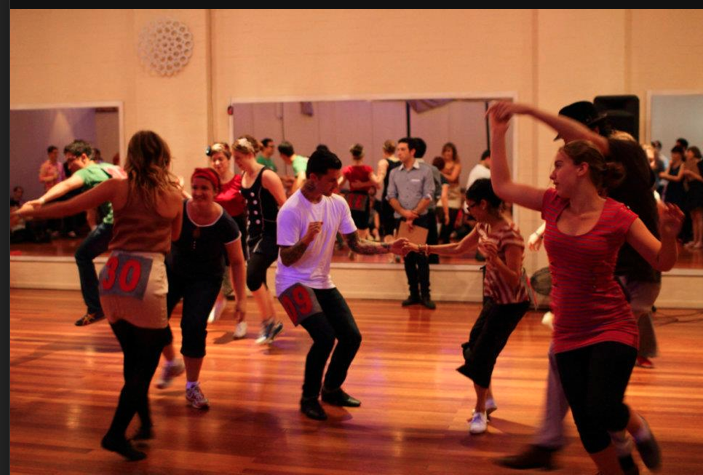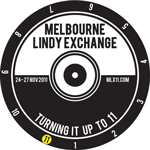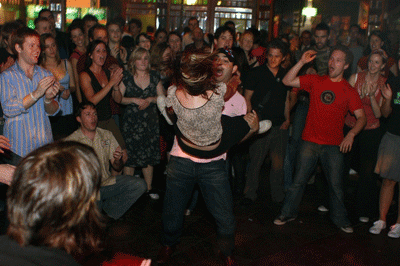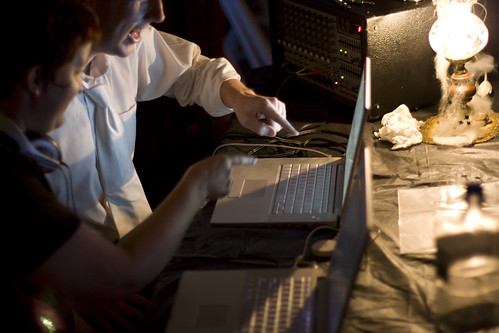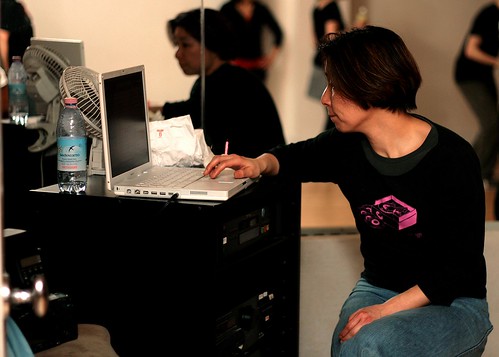I’ve just had a LOVELY weekend at Sea of Rhythm, a new dance event held in Melbourne. Run by Rhythm Tap, a group who do the sort of tap that lindy hoppers like, the program was intended to bring together dancers who were interested in dances of the African diaspora. Not that the event was pitched like that. It was literally pitched as a ‘sea of rhythm’ event, where dancers would come and immerse themselves in rhythm-based dances for a weekend. That meant African (Senegalese) dance and drumming, lindy hop, rhythm tap, historic solo jazz dance – all the good stuff!
I’ve been to a few of these sorts of weekends before, but this one was different for a couple of reasons. The most important of which was that the teachers and performers weren’t just random people from around town. They were top shelf dancers and teachers. The other key reason for the success of the weekend, was that the teachers were all approaching dance from the same ideological position. They see dance as an embodiment of music, or more specifically, they approach all dance as rhythm first.
This approach to dance has become quite popular in the mainstream lindy hop community lately (and isn’t that a strange thing to write – ‘main stream lindy hop’), but it’s something the Swedes have been talking about forever, and they’ve been talking about it because they’ve always worked very closely with the old timers – Frankie Manning, Al Minns, Norma Miller and so on. And the African American dancers always put the music first. Lindy hop hasn’t been well served by that deviation into ‘smooth’ and heavily technique-focussed teaching in the early 2000s. That movement away from hot jazz, and that strange emphasis on ‘connection’ took us a little too far from the roots of lindy hop.
I’ve very interested in talking about ‘rhythm’ as a teaching tool. I think that it’s very useful for teaching beginners the essentials.
Bounce (that’s the beat, or the time of the song) teaches us how to swing and stay in time, but also teaches us how to find a common point of reference for our partnership, so we can stay in time together. It’s also a powerful tool for teaching people to engage their cores (and relax their upper bodies as a consequence), and to improve their fitness (because it’s physically more work). It’s also – I very strongly believe – the most basic way for two people to dance together. You can just hold each other in your arms and bounce on the spot, and you’re dancing. It’s also (to get a bit essentialist here – I apologise), quite primal to bounce up and down to music with another person. Watching Josette Wiggins tap this weekend, heavily pregnant, I kept thinking: that is the point of this. We know how to do this, right from birth.
I also have quite a manically obsessive hatred of dancing that rushes the beat. Especially since taking tap classes. It really, REALLY shits me to have people in class rush the beat and make a basic rhythm speed up. Teaching, we see beginners do that at first (because humans do), but everyone of them can stop doing it within half an hour of their first class. If I’m in an intermediate or advanced lindy hop class and people speed up, I want to SCREAM. Because the people who do this are the people who don’t bounce.
Tap dancers don’t bounce, but they do have a shared sense of time. Bouncing is kind of a cheat, because it makes it easier to feel and find that shared sense of time. Tappers have that sense of time in their brains and bodies.
Teaching ‘steps’ or ‘footwork’ as rhythms instead is very exciting. Straight away, the students learn that rhythms are central to what we do, not just an add-on to the shapes or ‘moves’. And lindy hop is special: the syncopation of the triple step is so important.
After the speeding up of basic rhythms, I really hate it when people flatten out a syncopated rhythm. I think it’s something to do with tighty whitey dancing: lindy bro leads are the absolute worst for rushing the beat and flattening out syncopation. I know that follows tend to be a bit more behind the beat, but PLEASE: TAKE CARE OF THE RHYTHM! It feels so naff – why are you rushing?
I feel as though this issue is related to the tension between hot and cool in African American and African dance. Be cool. I’ll need to think more about that, though, before I can articulate it properly.
Scatting is essential. Again, the Swedes have always done it, because the old timers have always done it. Norma Miller rants about it. And I’ve transitioned almost completely to teaching entirely without counts in class. It’s a joy. I scat all the time now, to the point that I can’t actually turn it off when I dance.
I generally find that ‘1 2 3 4 5 6 7 8’ even with ‘ands’ in there simply aren’t complex enough tools for describing what happens in jazz dance. The beats don’t divide evenly into single beats or half beats. Just syncopation alone is far more complex. There’s a difference just between the timing of a stomp off and a triple step that counts can’t reflect. I find it much more useful to use sounds that sound like the way a movement feels. Which I guess is like reverse-engineering dancing to music. So if we do start with the music first, a musician plays a series of notes in a particular way, and then I find a way to make that sound visible with my body. Counts don’t really come into it.
I suppose what I’m really talking about is a profound ideological shift in approaching dance. From a very anglo-western, ‘scientific’ concert/performance approach, to a more ‘African’ or African American vernacular approach. From thinking about dance and music as things to be performed, watched and consumed, to things that should be created, participated in, enjoyed, eaten up and shared.
I wrote about ‘pavlov’s lindy hopper‘ a little while ago, where I talked about how watching other people dance does things to your brain: it fires you the bits of your brain that perform those movements. Particularly if you’re familiar with those movements. Dancers often talk about not watching dance clips before bed because it fires you up.
I suspect that scatting works this way. When we scat, we physically make the sound that the music makes, and that triggers something in our brains. So we move from just ‘observing’ or ‘consuming’ music, to participating in music. If dancing is a way to participate in music, then scatting is the natural bridge between the two. Or more usefully, it’s the olive oil that marries the flavours.
WHAT does all this have to do with Sea of Rhythm?
Well, I think that this is the HEART of what was happening. We know that tap dancing is a way for dancers to ‘join the band’, to make the sounds that they are dancing, rather than just ‘making sound visible’, they ‘make visible sound’. In the African dance class on the weekend, I think that this process was made very simple and clear.
We began by sitting in a circle, with our feet in, and this was called the ‘circle of life.’ Now, if you’re immediately made uncomfortable by that sort of talk, you might want to get a grip. It’s not so much hippy talk as a different way of talking and thinking about the role of music and dance in everyday life, from another culture. Anyone who’s been to a lindy hop class knows how important circle formations are to group dynamics. When I was tutoring, I’d make all the students sit in a circle, because it made it much easier to manage behaviour problems: people wouldn’t be able to sit in the back and dick around. They had to be right there, facing everyone, and accountable for everything they said and did. They had to be part of the group. And anyone who’s ever done a big apple (called or social) knows how circles make you feel. And of course, ring shouts make the roots of Africa so clear. All the tap classes over the weekend used circles as well – we’d stand in a circle and take turns doing step or a time step. And haven’t we all seen how a jam circle works? What it does to our brains and bodies to be leaning into a circle when the music is hot?
In our African dance class, we all sat in the circle of life, and our teacher was there, with us, part of that circle. Our teacher, but one of us. He explained what we’d be doing, and what his background was, and how things worked.
Then we moved to another part of the room, where the drums were set up in a circle. We all took a drum (or shared one), and began learning some simple drumming techniques. Our teacher would say something like ‘the rain is coming, gently’, and he’d tap a gentle tappity tap, and we’d just join in. And so on. The important points: he’d just begin, and we’d just join in. Then we stood up and started learning a routine. Our teacher would drum and we’d dance. I didn’t have any moments of feeling shy or uncomfortable. It was really fun, and we all felt really excited by this stuff.
I knew that this would be fun and exciting, but I didn’t quite anticipate what it would mean to have my teacher drum. He could vary the tempo, the length of time we spent doing each step, and how we felt. It was very exciting. And because we’d first learnt to drum the rhythms ourselves, it was as though we’d skipped scatting and gotten straight to the heart of it.
This was really the message of the whole weekend: we have to take care of the rhythm. It was also made very clear that we each had a responsibility to make the rhythms clear and sharp. Each of our teachers worked on us with this: our tap teachers, our African teacher, our solo jazz teachers, our lindy hop teachers. You have to properly understand the rhythm, before you can dance it. Or rather, you can only really understand the rhythm if you dance it.
This meant that the entire weekend the focus in all the classes wasn’t so much on ‘learning a move’ and then perfecting it, as learning a rhythm (or creating one!) and then figuring out just how many different ways you could dance it. Of course, the unspoken (and occasionally spoken) emphasis here was on individual personality and creativity, but in a collective environment. It’s quite an exciting approach, because mixed level classes suddenly become a real advantage: here is a room of people who are really diverse and different, which means you have a WHOLE ROOM FULL OF PEOPLE to inspire you, that you can suck inspiration from, who’ll fire up your creativity. How will you make this rhythm work with someone who’s never danced before? Or when I was was dancing with a pre-teen boy tap dancer in a beginner lindy class: how do I make this work with someone half my height and feeling weird about holding a grown woman in his arms?
I think it goes without saying that all weekend there was this absolute TRUTH that there is no distinction between ‘solo dancing’ and ‘partner dancing’. Even when we were dancing alone – or perhaps most when we were ‘dancing alone’ – we were actually part of a group, dancing together. This is where that whole thing about speeding up the tempo comes in: we were a group, so we all had a responsibility to take care of that rhythm and not speed it up or flatten out the swing or syncopation. Tap made this particularly clear, because we could hear the differences, and we had to bring everyone with us. It was a marvellous tension between uniformity and diversity. We had to be together, but we also had to be uniquely ourselves. We had a responsibility to contribute to the group, and to be responsible for our own actions. This approach meant that respecting each other was just taken for granted.
And the best part is that when we come back to our lindy hop, we can still throw down and do solid, hardcore lindy hop. No hippy stuff; just fucking hardcore lindy hop. All this stuff sort of fills in the backgrounds and body of our dancing.
It was quite a magical experience, really. It reminded me so much of the Frankie stream at Herrang. This is what it means to be a jazz dancer.

